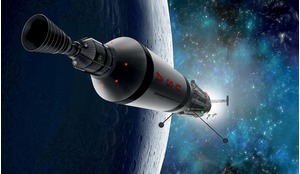In a unique new book, space entrepreneur and international author Jeffrey Manber retells the history of space exploration, from when the first visionaries realised the timeless dream of rocket travel in the early 1900s to the similarities of the space communities that erupted first in Russia and then Germany before the first rockets were even constructed. This article, based on edited extracts from his book along with a selection of graphic illustrations, provides an enthralling context for where we have arrived at today.
The origins of space travel have always been a mystery for me. Despite being involved in the community long enough to question America’s single-point dependency on the unproven Space Shuttle, much of the influencing factors have always been murky.
I knew of Dr Robert Goddard and his pioneering efforts on liquid propulsion rockets, but history remembers Goddard as a recluse. And when I worked with my Russian colleagues they told me of Konstantin Tsiolkovsky. But he was a loner living in a small town hours from Moscow, wasn’t he?
We all knew of Wernher von Braun which only deepened my puzzlement. How did America become so dependent on von Braun and his German team to realise the dream of reaching the Moon?
The questions were deeply personal. As young boys, my brother and I promised ourselves that we would be living on Mars by the distant year of 2000. Nope. Not even the Moon. Frustrating.
Several years ago I set out to find the spark that took the dream of space travel from fantasy to reality. The results were surprising, even stunning. I never expected that the magical ingredients included failed graduate students, famous film directors, overlooked visionaries, stubborn optimists, untrustworthy politicians and successful businesspeople. All of them knew, communicated with, and in many ways, competed against one another across national boundaries in the 1920s to realise the first rockets.
I decided to share the incredible story from the perspective of one who has been in commercial space for several decades, pushing to make space more like other emerging markets. And soon enough I realised that the historic graphic novel was the perfect medium, squarely in the intersection of the videos so popular today with the nuances of more traditional literature.
I reached out to two great artists with differing styles. I was drawn to Shraya Rajbhandary’s bold, sweeping illustrations to reveal the power of the first generation of ‘rocket travel’ supporters. And Jay Mazhar drew the comic strips, the ‘pencils’ and kindly did the lettering as well. His classic style makes clear the factual nature of the strips.
There is one exception to the accuracy of the strips and the text, and that is the last cartoon, which has all the major rocket pioneers of the 1920s gathered together in a German beer hall. Otherwise, my book is non-fiction. Okay, a highly opinionated work, but non-fiction nonetheless!
In terms of recent writings, Asif A Siddiqi has written the most on the space crazes of the 1920s and Frank S Winter authored a detailed look at the early rocket societies and their influence on driving the exploration programme, Prelude to the Space Age: The Rocket Societies 1924-1940.
It was also Winter, along with colleague Martin Harwit, who conducted the interview in the 1980s with Hermann Oberth, which is a wonderful portrait of the rocket pioneer looking back, or sometimes refusing to re-examine, his career.
Space exploration is too often a business with both eyes on the future. But understanding the past is vital to make sure we avoid the previous stops and starts and make exploration sustainable and impactful for all of us. That is the goal here.
Rocket man
Do we really need space agencies? No industry has a dedicated government agency for a single market effort except for space
On the morning of 16 July 1969, the crew of NASA’s Apollo 11 blasted off on the journey that would - at long last - take humans to the surface of the Moon. Among the millions watching, none had done more to realise this epic journey than one Wernher Magnus Maximilian Freiherr von Braun, the first director of NASA’s Marshall Space Flight Center in Huntsville, Alabama.
The realisation of humans at long last walking on the lunar surface launched von Braun into the rarefied atmosphere of celebrated American icon, one who reflected the can-do spirit of so many immigrant visionaries. But still, von Braun was not satisfied. At liftoff of the giant rocket, von Braun, watching from the Mission Control room, blurted out, “give me 10 billion dollars and I’ll get a man to Mars”.
The path that took von Braun to the Apollo 11 Mission Control room has often been hidden, ignored, celebrated or reviled. But it is the history of the rocket’s journey in the 20th century and says much about the forces tugging at our exploration of space, never more so than today, as we seek to live and work not just on the Moon but on Mars as well.
Wernher von Braun was a visionary who eagerly worked with both John F Kennedy and Adolf Hitler to implement his dreams of rocket travel. He was also a pragmatist who willingly developed the first wartime missiles because he understood the same technology could be used to take humanity into space.
Thus, the unholy alliance between the rocket pioneers and national governments was born. Von Braun was not alone. In Russia, Sergei Korolev and Valentin Glushko found themselves dealing with Stalin and later Soviet premier Nikita Khrushchev. So too the Chinese rocket/missile pioneer Qian Xuesen with both American and Chinese leaders.
Nuclear funding
American, Chinese and Russian leaders funded the development of the huge rockets of the nuclear age that also allowed space visionaries to develop civilian programmes that fulfilled our timeless dreams of space travel. Each side used the other.
At what price was this dependency on government funding for rocket travel achieved? The great innovations of the 20th century were all driven by entrepreneurs, whether for automobiles, trains or aeroplanes, or more recently, computers, the internet, biopharma or robotics. All these entrepreneurs worked closely with their governments but the innovation was driven by the private sector.
The result was efficiency in costs and agility in innovation, with governments as customers, not operators of the new technologies. So why has rocket travel been treated differently - with a total reliance on public funding and the whims of politicians?
Space agents
What should we do next? What is the right mix of government support for space exploration? These are really important questions that will determine how we live and work on the Moon and on Mars
Even today space remains unique. NASA runs the American space programme. There is the European Space Agency, Australian Space Agency, Russian Space Agency, UAE Space Agency.
All technically advanced countries now have a space agency. But why? No industry has a dedicated government agency for a single market effort except for space. There is no internet agency, no automobile agency, no plane agency, no biopharmaceutical or robotics agency. Do we really need space agencies?
Think about how different space travel would be today if rocket development had remained commercial like all other emerging industries. By now we would have colonies on the Moon and explorers on Mars. A dozen space stations would be manufacturing high-quality medicine and materials for use on Earth or serving as hotels for those seeking the ultimate journey.
Von Braun and many of the other pioneers took what was offered to realise the timeless dream to travel beyond Earth. By doing so, they abandoned their early idealism and helped make space exploration a uniquely governmental programme from which we are only just emerging.
What should we do next? What is the right mix of government support for space exploration?
These are really important questions that will determine how we live and work on the Moon and on Mars. But these questions can only best be answered once we know the surprising story of how the rocket pioneers launched humanity into the space frontier.
About the author
Jeffrey Manber has done everything from writing about space exploration to leasing the Russian space station Mir, and today he is part of a team that is building a privately owned space station. His work has been widely published, including in the New York Times and other publications, and he is the author of Selling Peace, the inside story of working with the Russians in space. Jeffrey is the recipient of numerous awards, including the NASA Exceptional Public Achievement Medal. Jeffrey has long believed the best path forward for space travel and space stations is one that is led by commercial companies, like all other emerging markets and that the best chapter in space exploration has only just begun!














